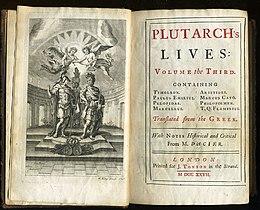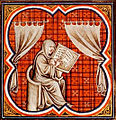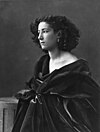Portal:Biography
The Biography Portal

A biography, or simply bio, is a detailed description of a person's life. It involves more than just basic facts like education, work, relationships, and death; it portrays a person's experience of these life events. Unlike a profile or curriculum vitae (résumé), a biography presents a subject's life story, highlighting various aspects of their life, including intimate details of experience, and may include an analysis of the subject's personality.
Biographical works are usually non-fiction, but fiction can also be used to portray a person's life. One in-depth form of biographical coverage is called legacy writing. Works in diverse media, from literature to film, form the genre known as biography.
An authorized biography is written with the permission, cooperation, and at times, participation of a subject or a subject's heirs. An autobiography is written by the person themselves, sometimes with the assistance of a collaborator or ghostwriter. (Full article...)
Featured biographies –
Bronwyn Joy Oliver (née Gooda, 22 February 1959 – 10 July 2006) was an Australian sculptor whose work primarily consisted of metalwork. Her sculptures are admired for their tactile nature, aesthetics, and technical skills demonstrated in their production.
Oliver was raised in rural New South Wales. She trained at Sydney's Alexander Mackie College of Advanced Education and London's Chelsea School of Art. She had early success, winning a New South Wales Travelling Art Scholarship in 1981 and the Moet & Chandon Australian Art Fellowship in 1984. Oliver settled in Sydney, where she practised and taught until her death in 2006. (Full article...)
Terence Martin Griffiths OBE (born 16 October 1947) is a Welsh retired professional snooker player and current coach and pundit. After winning several amateur titles, including the Welsh Amateur Championship in 1975 and back-to-back English Amateur Championships in 1977 and 1978, Griffiths turned professional in June 1978 at the age of 30. In his second professional tournament, he qualified for the 1979 World Snooker Championship. He reached the final of the event where he defeated Dennis Taylor by 24 frames to 16. This was only the second time a qualifier had won the World Snooker Championship, after Alex Higgins in 1972; only Shaun Murphy in 2005 has since emulated the achievement. In 1988, Griffiths again reached the final of the competition. He was tied with Steve Davis, 8–8, but lost the match 11–18.
Griffiths reached at least the quarter-finals of the World Championship for nine consecutive years, from 1984 to 1992. He also won the Masters in 1980 and the UK Championship in 1982, completing snooker's Triple Crown. Griffiths was runner-up at the Masters three times and reached the final of the 1989 European Open, where he lost the deciding frame to John Parrott. (Full article...)
John Crepps Wickliffe Beckham (August 5, 1869 – January 9, 1940) was an American attorney and politician who served as the 35th governor of Kentucky and a United States senator from Kentucky. He was the state's first popularly-elected senator after the passage of the Seventeenth Amendment.
Descended from a prominent political family, Beckham was chosen as the running mate of Democratic nominee William Goebel in the 1899 Kentucky gubernatorial election. Although Goebel lost the election to Republican nominee William S. Taylor, the Kentucky General Assembly disputed the election results. During the political wrangling that followed, an unknown assassin shot Goebel. A day later, the General Assembly invalidated enough votes to give the election to Goebel, who was sworn into office on his deathbed. Taylor claimed the election had been stolen by the Democratic majority in the General Assembly, and a legal fight occurred between him and Beckham over the governorship. Beckham ultimately prevailed and Taylor fled the state. Beckham later won a special election to fill the remainder of Goebel's term and then an election in his own right in 1903. (Full article...)

Stanley Augustus Holloway OBE (1 October 1890 – 30 January 1982) was an English actor, comedian, singer and monologist. He was famous for his comic and character roles on stage and screen, especially that of Alfred P. Doolittle in My Fair Lady. He was also renowned for his comic monologues and songs, which he performed and recorded throughout most of his 70-year career.
Born in London, Holloway pursued a career as a clerk in his teen years. He made early stage appearances before infantry service in the First World War, after which he had his first major theatre success starring in Kissing Time when the musical transferred to the West End from Broadway. In 1921, he joined a concert party, The Co-Optimists, and his career began to flourish. At first, he was employed chiefly as a singer, but his skills as an actor and reciter of comic monologues were soon recognised. Characters from his monologues such as Sam Small, invented by Holloway, and Albert Ramsbottom, created for him by Marriott Edgar, were absorbed into popular British culture, and Holloway developed a following for the recordings of his many monologues. By the 1930s, he was in demand to star in variety, pantomime and musical comedy, including several revues. (Full article...)
Charles Hercules Green DSO (26 December 1919 – 1 November 1950) was an Australian military officer who was the youngest Australian Army infantry battalion commander during World War II. He went on to command the 3rd Battalion, Royal Australian Regiment (3 RAR), during the Korean War, where he died of wounds. He remains the only commanding officer of a Royal Australian Regiment battalion to die on active service. Green joined the part-time Militia in 1936, and before the outbreak of World War II had been commissioned as a lieutenant. He volunteered for overseas service soon after the war began in September 1939, and served in the Middle East and the Battle of Greece with the 2/2nd Battalion. After the action at Pineios Gorge on 18 April 1941, Green became separated from the main body of the battalion, and made his way through Turkey to Palestine, to rejoin the reformed 2/2nd Battalion. The 2/2nd Battalion returned to Australia in August 1942 via Ceylon (modern Sri Lanka), to meet the threat posed by the Japanese.
Green performed instructional duties and attended courses until July 1943 when he rejoined the 2/2nd Battalion as its second-in-command. At the time, the unit was training in Queensland. From March to July 1945, Green commanded the 2/11th Battalion during the Aitape-Wewak campaign in New Guinea. For his performance during the campaign, Green was appointed a Companion of the Distinguished Service Order. After the war, Green briefly returned to civilian life and part-time military service as commanding officer of the 41st Battalion. When the Regular Army was formed, Green returned to full-time service in early 1949. (Full article...)
Vice Admiral Sir Roy Russell Dowling, KCVO, KBE, CB, DSO (28 May 1901 – 15 April 1969) was a senior commander in the Royal Australian Navy (RAN). He served as Chief of Naval Staff (CNS), the RAN's highest-ranking position, from 1955 until 1959, and as Chairman of the Chiefs of Staff Committee (COSC), forerunner of the role of Australia's Chief of the Defence Force, from 1959 until 1961.
Born in northern New South Wales, Dowling entered the Royal Australian Naval College in 1915. After graduating in 1919 he went to sea aboard several Royal Navy and RAN vessels, and later specialised in gunnery. In 1937, he was given command of the sloop HMAS Swan. Following the outbreak of World War II, he saw action in the Mediterranean theatre as executive officer of the Royal Navy cruiser HMS Naiad, and survived her sinking by a German U-boat in March 1942. Returning to Australia, he served as Director of Plans and later Deputy Chief of Naval Staff before taking command of the light cruiser HMAS Hobart in November 1944. His achievements in the South West Pacific earned him the Distinguished Service Order. (Full article...)
Alan Bartlett Shepard Jr. (November 18, 1923 – July 21, 1998) was an American astronaut. In 1961, he became the second person and the first American to travel into space and, in 1971, he became the fifth and oldest person to walk on the Moon, at age 47.
A graduate of the United States Naval Academy at Annapolis, Shepard saw action with the surface navy during World War II. He became a naval aviator in 1947, and a test pilot in 1950. He was selected as one of the original NASA Mercury Seven astronauts in 1959, and in May 1961 he made the first crewed Project Mercury flight, Mercury-Redstone 3, in a spacecraft he named Freedom 7. His craft entered space, but was not capable of achieving orbit. He became the second person, and the first American, to travel into space. In the final stages of Project Mercury, Shepard was scheduled to pilot the Mercury-Atlas 10 (MA-10), which was planned as a three-day mission. He named Mercury Spacecraft 15B Freedom 7 II in honor of his first spacecraft, but the mission was canceled. (Full article...)
















































